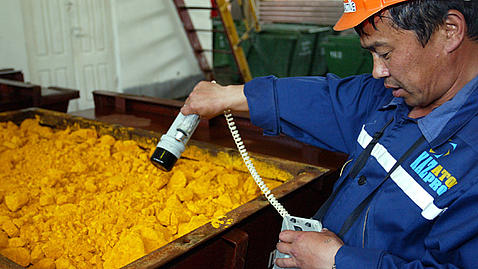
India Looses out to China in Central Asia’s Uranium Competition
Publication: Eurasia Daily Monitor Volume: 10 Issue: 183
By:

During the first week of October 2013, a high-level delegation of India’s Department of Atomic Energy visited Uzbekistan to discuss bilateral cooperation in the field of nuclear energy. According to several informal reports published in the Indian media, New Delhi expects to sign a four-year uranium supply contract with Tashkent by the end of December, in line with its current plans to boost nuclear power generation in the near future. Should this deal be concluded, India could, as of 2014, start to import some 500 tons of low-enriched uranium per annum from Uzbekistan, whose estimated uranium reserves are currently believed to hover somewhere around 185,000 tons. At such a rate, the Indian government is set to secure at least 2,000 tons of combined uranium supplies from this Central Asian republic in the course of the next four years (Press Trust of India, October 6; Ca-news.org, October 8).
In fact, India is desperately seeking to ensure stable uranium supplies from the world’s key producers in a context where its nuclear energy needs remain largely unsatisfied and are expected to further grow in the years to come. While India already imports over 50 percent of its uranium needs every year, its demand for this strategic mineral resource is projected to triple by 2021. At the same time, Indian authorities aim to increase the share of nuclear energy in their country’s electricity generation to some 25 percent by 2050, whereas it represented only 2.5 percent back in 2007. To achieve this goal, New Delhi plans to build 16 more nuclear reactors by no later than 2022, in addition to the 19 reactors that already operate throughout the country (Mineweb.com, October 11; Press Trust of India, October 6).
India’s external partnerships focusing on prospective uranium sales to New Delhi have recently become particularly dynamic. Since 2009, the Indian government reached civil nuclear cooperation and joint project deals with Namibia, Mongolia, Russia, France and the United States. It also aspires to set up a long-term working relationship with Australia, the world’s third largest uranium producer. Recent bilateral meetings suggest that New Delhi may soon become Canberra’s first uranium customer that is not a party to the Non-Proliferation Treaty (NPT). Furthermore, Canadian authorities have also recently allowed the direct trade of nuclear materials with India (Mineweb.com, October 11; Hindustan Times, October 10; Indian Express, September 15, 2009).
As regards Indian-Uzbekistani nuclear energy cooperation, the possibility of stable uranium supplies to New Delhi was previously discussed in May 2013 during the visit of Indian Vice President Mohammad Hamid Ansari to Tashkent. Later in September, India’s foreign minister, Salmad Khurshid, further touched upon this delicate issue during his visit to Uzbekistan. Despite these multiple overtures, the success of India’s expanding uranium diplomacy in Central Asia’s most populous country is being threatened by the similarly wide ambitions of neighboring China. In August 2009, Beijing’s CGNPC Uranium Resources Co. and Tashkent’s Goskomgeo already established a joint-venture, UZ-China Uran, entrusted with both exploration and production at Uzbekistan’s most promising uranium deposits. While the authorized capital of this entity was increased earlier this year from $4.6 million to some $8.6 million in order to account for its constantly expanding commercial stakes, this company still remains the country’s only operator with direct foreign participation. Furthermore, this March, the joint-venture was granted operating rights over a new uranium deposit of undisclosed value (Noviyvek.uz, March 26; Regnum.ru, March 18; 12uz.com, November 23, 2012).
In a similar vein, India’s attempts to secure long-term nuclear supply contracts in Kazakhstan, which currently tops the global list of uranium producers, have been taking place in a context of China’s rapidly growing influence as a large-scale consumer in this market. Although Indian Prime Minister Singh’s visit to Astana in April 2011 permitted to make public a bilateral agreement on the supply of some 2,000 tons of locally extracted uranium to India by 2014, little progress has been achieved so far on this front. And while the same issue was raised once again on the occasion of Kazakhstani Foreign Minister Erlan Idrissov’s visit to New Delhi this past March, Kazakhstan is increasingly poised to favor China as its primary uranium buyer. According to official statistics, Kazakhstan has recently been exporting almost 60 percent of its uranium to neighboring China. In January–August 2013, this Central Asian republic supplied eastward more than 4,600 tons of its uranium, out of which some 2,000 tons were sold to Beijing in July alone (Ktk.kz, September 23; Meta.kz, April 16, 2011).
As both India and China are trying to secure long-term access to Central Asia’s vast energy resources, including oil, gas and uranium, Beijing has considerably reinforced its regional stakes in recent years by offering lucrative contracts and directly working with the local regimes. Instead, India’s strategy has largely lacked cohesiveness, which recently led to such large-scale failures as Kazakhstan’s refusal to approve the sale of ConocoPhillips’ share in the Kashagan oil deposit to India’s ONGC Videsh Ltd. In early September, it was actually China’s CNPC that finalized its much-awaited entry into the world’s most expensive energy project. Finally, China’s strategy for the gas-rich Turkmenistan represents another serious threat to India’s ambitious project focusing on the projected supply of Turkmenistani gas to South Asia via the Turkmenistan-Afghanistan-Pakistan-India (TAPI) pipeline network. While India may still attempt to preempt China’s future moves, its strategic positions in Central Asia look increasingly bleak.




